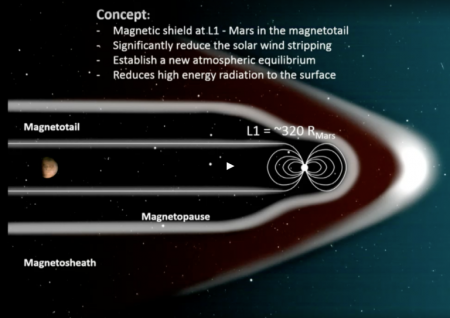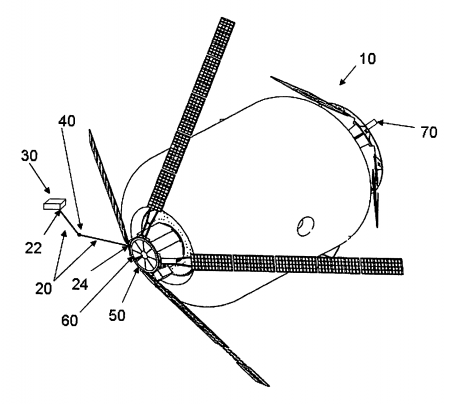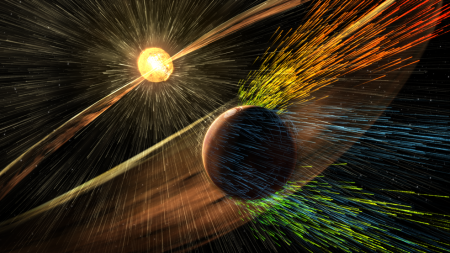March 7, 2017 – In science fiction writers can come up with planet-wide magnetic shields and Death Stars. But in reality?
At the recent Planetary Science Vision 2050 Workshop, held at NASA headquarters in Washington, DC, one scientist proposed that we could terraform Mars simply by deploying a “magnetic shield” placed in a stable orbit around the planet to minimize high-energy solar particles from bombarding the planet.
The scientist in question is Jim Green, NASA Planetary Science Division Director. In his talk, “A Future Mars Environment for Science and Exploration,” he described how a magnetic shield placed at a Mars Lagrange Point could do what the Van Allen Belt does for Earth. Without Earth’s natural-occurring magnetic field, our planet would more resemble Mars than the habitable world we see today despite global warming. So adding a magnetic field ad depicted in the illustration below could produce a significant change to the planet’s atmosphere.

In simulations, with shield deployed, Mars could regain an atmospheric pressure half that of Earth at sea level in “a matter of years.” The paper describes with an early deployment within the next decade, Mars would be a very different place by 2040. Conditions on the surface and in the atmosphere would change dramatically. The mostly frozen carbon dioxide, found at the poles, would sublimate into the atmosphere to become a greenhouse gas. And water trapped in
Conditions on the surface and in the atmosphere would change dramatically. The mostly frozen carbon dioxide, found at the poles, would sublimate into the atmosphere to become a greenhouse gas. And water trapped in sub-surface, and polar ice would begin to melt forming lakes on the planet’s surface.
What kind of magnetic shield could we deploy?
It would likely be an inflatable structure or structures launched from Earth or assembled in near-Earth or lunar space that would then be sent to Mars where upon opening would generate a “1 to 2 Tesla (or 10,000 to 20,000 Gauss) as an active shield against the solar wind.” If you are not familiar with a Tesla, it is a commonly used metric unit to describe magnetic field strengths, and not an electric car.
Green and colleagues describe in their paper a future vision of Mars with significant surface liquid water. Revived Mars would be “much like Earth” with an “enhanced atmosphere” to “allow larger landed mass of equipment to the surface, shield against most cosmic and solar particle radiation, extend the ability for oxygen extraction, and provide ‘open air’ greenhouses to exist for plant production.”
Do we have the technology to do this?
Research into the field of magnetic shields, particularly for protecting spaceships on future missions is underway. At the Thayer School of Engineering, Dartmouth College, research on active shields capable of deflecting cosmic particles from harming human crews is underway. The trick is to design the magnetic shield just right so that it doesn’t do harm to the people it is trying to protect. It also means figuring out optimal positioning of a deployed shield surrounding the spacecraft. The illustration of a spacecraft magnetic shield, depicted below, comes from a patent filed in 2011 by Robert Bigelow of Bigelow Aerospace.

The alternative to magnetic shields is to find materials sufficiently capable of blocking cosmic rays from penetrating a spaceship.
There are proposals to harvest water from icy asteroids and store the fluid in tanks strapped to the outside of a spaceship to inhibit charged particles.
Another is to take the waste produced by a crew during spaceflight and store it on the outside of the ship to act as shielding, literally a flying ball of feces providing protection.
How much power would be required for an effective spaceship magnetic shield?
A shield strength of fewer than 0.1 Teslas is considered sufficient. Such a field could be energized by as little as a 500-Watt power source with the entire structure no bigger than a large desk. A planetary shield would be 10 times the size. Deployed with photovoltaic panels it could generate the energy needed to operate it in near-Martian space.
Fantasy, science fiction, or a future reality? What do you think?
















